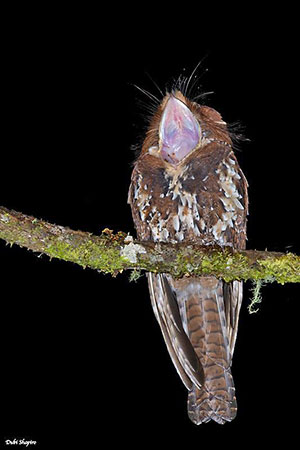
FAMILY AEGOTHELIDAE
Owlet-nightjars
The family Aegothelidae gathers nine species in a single genus (Aegotheles) very similar to Strigidae but also to Caprimulgidae and frogmouths. Depending on the authors, this family is part of the order Apodiformes, following morphological comparative studies.
But recently, the IOC World Bird List included this family in its own order Aegotheliformes, since morphological studies of the cranium in the 1960s.
Owlet-nightjars are an exclusively Australasian group but they are poorly known. Most species are native to New Guinea, with some extending to Australia, the Moluccas and New Caledonia.
A species native to New Zealand was named New Zealand Owlet-nightjar (Aegotheles novaezelandiae), but it has been extinct by the early 13th century.
It was a giant bird with 35 cm in length and a weight of 150-200 grams. The wings were short but the legs were long.
It is known through numerous bones, and was first placed in the genus Megaegotheles, being based on the relatively long and strong legs shown by the fossils. It was probably flightless or at least a very weak flier, as suggested by its small wings. It is likely to have had facial disks and forward facing eyes. The bill was small but with a large gape.
These physical features may have reflected more terrestrial activity than in any of the living species of this family.
As usual, the extinction of the species was caused by introduced Pacific rats, when the Maori arrived in New Zealand.
All species blend into their habitat. Their cryptic plumage is very similar to the bark of trees and allows them to hide very well when perched or resting on a branch. Moreover, they have mainly nocturnal habits, resulting difficult to observe them.
They are not globally threatened except for the New Caledonian Owlet-nightjar but all species are affected by habitat loss caused by deforestation and forest clearance.
Text by Nicole Bouglouan
Photographers:
Ken Havard
My Bird Gallery & Flickr gallery 1 & Flickr gallery 2
Dubi Shapiro
Dubi Shapiro Photo Galleries
Illustrator:
Joseph Smit: 1836-1929
These images and the text are subject to copyright and cannot be used without express authorization from the owners. Legal issues
Sources:
HANDBOOK OF THE BIRDS OF THE WORLD Vol 5 by Josep del Hoyo-Andrew Elliott-Jordi Sargatal - Lynx Edicions - ISBN: 8487334253
Owlet-nightjars, treeswifts, swifts
Phylogeny of the owlet-nightjars (Aves: Aegothelidae) based on mitochondrial DNA sequence
CREAGUS@Monterey Bay (Don Roberson)
Fatbirder - The World’s Richest Information Resource about Birds for Birders
Owlet-Nightjars: Aegothelidae - Physical Characteristics
Leesbird - Aegothelidae – Owlet-nightjars
Wikipedia, the free encyclopaedia

Feline Owlet-nightjar
Aegotheles insignis
Showing the wide gape
These small crepuscular birds have a tiny bill that opens extraordinarily wide surrounded by prominent bristle feathers, and open nostrils with well-developed facial bristles. The reddish-brown eyes face forwards but there is not clear facial disk.
The size ranges from 20 to 29 centimetres and the weight from 30 to 85 grams.
The plumage is very cryptic with brown, rufous, chestnut, grey and other paler colours, with or without dark and white markings overall. The wings are short and fairly rounded and the tail is long and rounded. Legs and feet are rather small, and usually weak. Male and female are similar.
The drab, cryptic colours and streaked or barred patterns exhibited by owlet-nightjars are primarily used to protect them from predators. The bolder markings are often restricted to pale half-collars on the hindneck of patches on the scapulars. Due to these peculiar features, the owlet-nightjars probably communicate by voice rather than by visual behaviour.
The plumage of the two largest species, the Feline Owlet-nightjar and the Molucan Owlet-nightjar, shows extensive areas of rufous to chestnut. On the other hand, the smaller species are mainly brown with a predominantly streaked pattern, or they are grey to blackish with mainly barred pattern.
The Australian Owlet-nightjar is 21-25 cm long, with longer and more pointed wings, whereas the tail is particularly long. Legs and feet are stronger too. It is well adapted to more open woodlands than other species, and frequents scrub in arid regions, low shrubland and can be seen feeding in open grassland. The populations living in the arid interior are usually paler and more rufous than the species living in humid, more wooded areas. It is present from sea-level to 1,000 metres of elevation.
It is found in Australia and S New Guinea, and it is sparsely distributed in Tasmania.
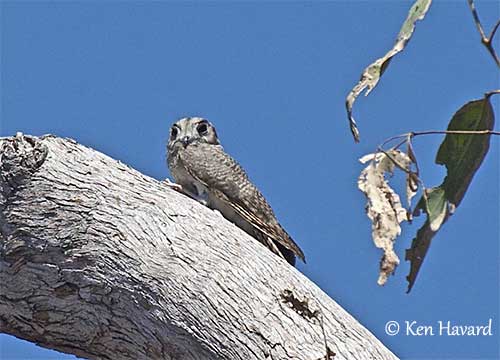
Australian Owlet-nightjar
Aegotheles cristatus
Other owlet-nightjars are mainly forest birds and occur in lowland or mountains, depending on the species.
The Mountain Owlet-nightjar is relatively small with a length of 18-20 cm and a weight of 36-40 grams. The species displays rufous and brown morphs. It is mainly found in forests on mountains, but it also frequents forest edges, gardens and tree-fern savannas. This species occurs between 800 and 3,700 metres of elevation.
It is found in the highlands of New Guinea.
The Feline Owlet-nightjar is probably the largest of this family with 28-30 cm and 50-85 grams, and it has brown and dark rufous morphs. It looks somewhat like cat, as the face has a feline shape, giving the bird its name.
Its habitat extends into forest edge, second growth and riverine woodland. It occurs between 1,150 and 2,800 metres, and occasionally up to 3,000 metres of elevation.
It is found in New Guinea.
The other species are mostly lowland birds.
The Molucan Owlet-nightjar is 29 cm long, and has brown and rufous morphs with intermediate. It occurs up to 1,800 metres.
It is endemic to the northern Moluccas.
The Wallace’s Owlet-nightjar is 20-23 cm long. It is a distinctive small bird living around 1,540 metres.
It is found in New Guinea.
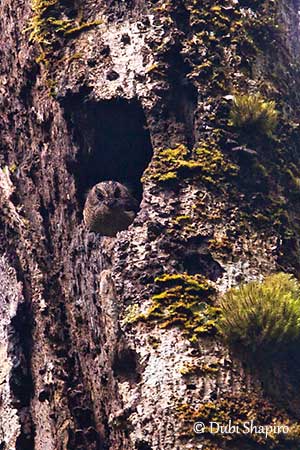
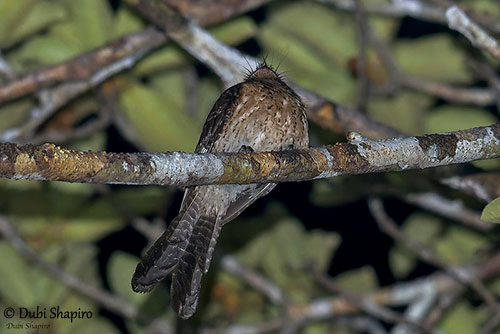
Wallace’s Owlet-nightjar
Aegotheles wallacii
The Barred Owlet-nightjar is 20-23 cm long and does not show polymorphic variations. It is found around 1,125 metres.
It occurs in New Guinea.
The Vogelkop Owlet-nightjar is 23 cm long and appears plump-bodied with large head. It was formerly a subspecies of the Barred Owlet-nightjar. It is found in lowland and hill-forest, between 80 and 1,500 metres.
It occurs in New Guinea.
The rare Starry Owlet-nightjar, also named Spangled Owlet-nightjar, is smaller with 25 cm long and less white markings than the Feline Owlet-nightjar. It is found in the lowland forest, around 100 metres of elevation.
It is endemic to Papua New Guinea.
The New Caledonian Owlet-nightjar is 28 cm long and is a dark-plumaged species. It occurs in humid riverine forest at about 1,000 metres of elevation. This species is very poorly known. It is endemic to New Caledonia’s Melaleuca savanna and humid forests (Melaleuca is a genus of numerous plant species in the myrtle family, Myrtaceae).
It occurs in SW New Caledonia.
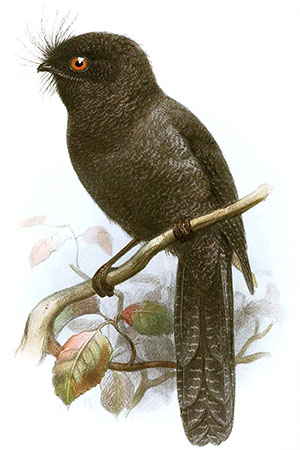
New Caledonian Owlet-nightjar
Aegotheles savesi
Joseph Smit: 1836-1929
Owlet-nightjars are secretive nocturnal birds. During the day, they usually roost in tree holes, although some of them also roost in clusters of dead leaves or dark tangles of shrubbery, or on a branch.
It is known that Feline, Mountain and Barred Owlet-nightjars often roost in tree holes, but the Feline Owlet-nightjar also roosts in clusters of dead leaves or tangled vines, whereas the Mountain Owlet-nightjar rests in dark tangles of shrubbery or the hollow end of a broken-off tree fern. A Barred Owlet-nightjar was reported roosting on a branch.
Several observations show awake owlet-nightjars at the entrance of the roosting hole during the day.
The Australian Owlet-nightjar may also use other types of holes or crevice such as crevices in cliffs or banks, hollows in termite mounds and inside roofs or abandoned nests of Pomatostomus species (babblers). However, the bird remains alert with the head erect while resting at roost.
The same sites are used year after year, and some territories may contain up to six roosting holes used in rotation. If the bird is disturbed, it quickly flies out and often moves directly into another roost-hole. But the bird may also disappear back inside into the hole.
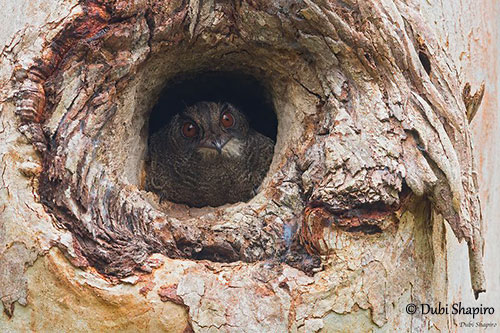
Barred Owlet-nightjar
Aegotheles bennettii
These small crepuscular birds are insect-eaters.
Almost all activities occur between dusk and dawn. This behaviour in very poorly known and nothing has been reported of the feeding techniques. They feed on a wide variety of insect species, including beetles.
However, the well-known Australian Owlet-nightjar sallies from perches and catches insects in the bill. It swoops onto prey from a low perch and catches it from ground or tree trunks, but is also hunts on the wing, flying low over the ground with rapid and regular wingbeats. From the study of gut contents, its diet includes a wide variety of small insects, and also spiders and millipedes.
The Moluccan Owlet-nightjar also catches insects by sallying from perches at mid-level in the forest, catching them in flight of by hover-gleaning from leaves.
The Mountain Owlet-nightjar feeds mainly on insects including Coleoptera and some Lepidoptera, Diptera and Orthoptera. But it also consumes a few earthworms giving evidence that it also forages on the ground. It forages usually at night beneath the forest canopy.
Both hunting behaviour and prey selection need to be more studied, but it seems clear that the prey are located and tracked visually, with chase of individual insects.
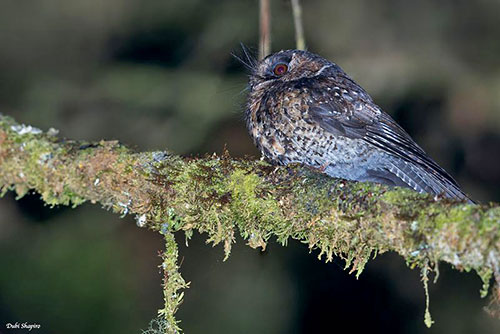
Mountain Owlet-nightjar
Aegotheles albertisi
The vocalizations of the owlet-nightjars are poorly known.
Only the Australian Owlet-nightjar is well known, and this species has four main types of calls. The commonest call is a high-pitched, grating, rattling “chirr-chiiirrr” given all year round by both adults often from a perch but also in flight. More abrupt versions of this call are uttered from the roosting cavity.
Other sounds are given during the nesting period. We can hear a high-pitched “yuk” by adult calling fledging young from the nest. They also produce hissing calls towards an intruder while brooding the chicks. The young utters a low trilling while begging for food.
SOUNDS BY XENO-CANTO
The Barred Owlet-nightjar gives a deep trill or a descending hollow “churr”, fairly similar to the call of the Australian Owlet-nightjar.
SOUNDS BY XENO-CANTO
The Mountain Owlet-nightjar has a very different call described as 2-4 soft whistles, each higher-pitched than the preceding one.
SOUNDS BY XENO-CANTO
The calls of the Moluccan Owlet-nightjar appear very different from those of other species. The bird utters a wide variety of screams and cackles. The call used in territorial advertisement is a weak, upslurred squeal or scream followed by 3 short, quiet screams on the same pitch. The alarm call is a series of wild, blood-curdling screams and also a cat-like yowling call.
SOUNDS BY XENO-CANTO
The calls of other nightjars are currently undescribed but some of them may have been recorded:
Feline Owlet-nightjar: SOUNDS BY XENO-CANTO
Wallace’s Owlet-nightjar: SOUNDS BY XENO-CANTO
Starry (or Spangled) Owlet-nightjar: SOUNDS BY XENO-CANTO
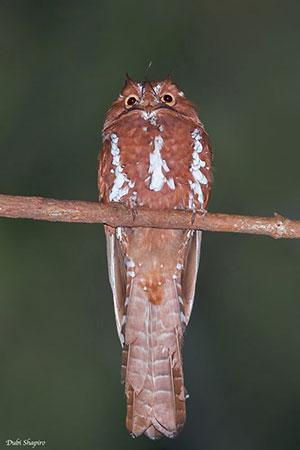
Starry (or Spangled) Owlet-nightjar
Aegotheles tatei
The lack of information makes difficult to describe the breeding habits of owlet-nightjars. Some nests have been found in hollows in dead tree stubs. The owlet-nightjars are monogamous with biparental care.
The Australian Owlet-nightjar has been more studied. It nests in holes in trees, sometimes in fence posts and fallen logs, crevices in buildings or even burrows in riverbanks. The nest entrance may be at ground level or up to 20 metres above the ground, but generally mostly between 1 and 5 metres.
The cavity is lined with fresh leaves of Eucalyptus or Acacia or pieces of bark. The laying occurs from August to December in the wide Australian range of this species.
The 3-4 white eggs are laid on this lining, and the fresh leaves of Eucalyptus and Acacia may have insecticidal properties.
Both parents share the nesting duties. The chicks fledge abruptly in the middle of the night, about one month after hatching. They remain with their parents for several months after fledging.
The nests of several owlet-nightjars are undescribed and are probably unknown.
Two nests of the Mountain Owlet-nightjar have been described. Both were in hollows in dead tree stubs. A single white egg was found in each case, but maybe incomplete clutches…
All species of the family Aegothelidae are suspected to be sedentary, except for the probable dispersal of the juveniles.
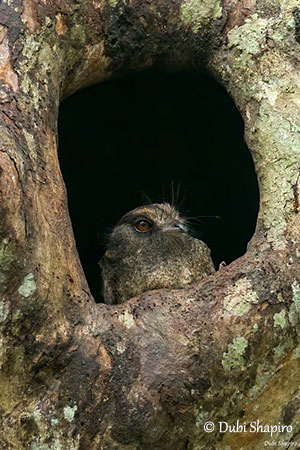
Barred Owlet-nightjar
Aegotheles bennettii
The owlet-nightjars are not globally threatened, except the New Caledonian Owlet-nightjar which is the only species with immediate conservation concerns. It was rediscovered in 1998, but it has not been seen or heard since. At this period, an expedition saw a large nightjar-like bird at dusk in Rivière Ni valley. This report suggests that the species is still surviving in small numbers in restricted remote areas, but this population is probably smaller than 50 individuals and still declining. This problem was caused by destruction of the habitat and predation by introduced predators.
The New Caledonian Owlet-nightjar is currently listed as Critically Endangered.
The Australian Owlet-nightjar is widespread and lives throughout Australia and New Guinea, and the species is not considered endangered and evaluated as Least Concern.
The Feline Owlet-nightjar is not globally threatened. It is widespread in remaining forested habitats in the mountains. It is evaluated as Least Concern.
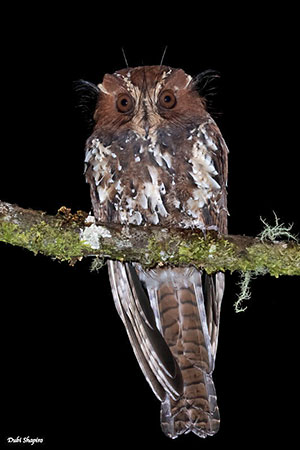
Feline Owlet-nightjar
Aegotheles insignis
The status of the rare Starry Owlet-nightjar, or Spangled Owlet-nightjar is currently unknown. In spite of extensive logging in New Guinea, large areas still remain intact. More information is needed.
The Wallace’s Owlet-nightjar is slowly declining due to logging and forest loss. But the species is currently evaluated as Least Concern.
The Mountain Owlet-nightjar is not globally threatened. More information is needed.
The Moluccan Owlet-nightjar has restricted range and may be affected by habitat loss, but it is not globally threatened.
The Barred Owlet-nightjar is not globally threatened despite deforestation. But large areas of rainforest still exist in most regions of New Guinea. The species is currently evaluated as Least Concern.
The Vogelkop Owlet-nightjar is probably affected by industrial logging and forest clearance for subsistence gardens. It is described as uncommon and declining. But currently, the species is not globally threatened. More information is needed.
Vogelkop Owlet-nightjar
Aegotheles affinis